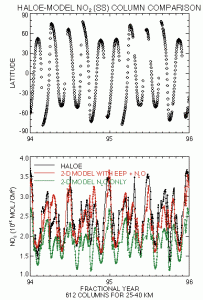Odd Nitrogen and electron precipitation
Essentially all 2-D models used for the assessments of the effects of mankind on global ozone include only the oxidation of N2O (a naturally occurring source gas) as a source of reactive nitrogen compounds in the stratosphere. These odd nitrogen compounds (NO, NO2 and others) are essential to the maintenance of the balance of global ozone. In 1991 Callis et al. (JGR, 96, 2939, 1991) postulated that varying fluxes of precipitating energetic electrons could form odd nitrogen in the mesosphere which may be transported into the stratosphere during periods of advective descent (late fall, winter, and early spring) and could modify the global balance of odd nitrogen and therefore global ozone. This was a controversial suggestion. In recent papers Callis et al. (GRL, 23, 1901, 1996; GRL, 24, 3237, 1997; GRL, 25, 1875, 1998; JGR, 103, 28405, 1998; JGR, 103, 28421, 1998) have shown that significant odd nitrogen is formed in the middle atmosphere by electrons precipitating from the outer trapping regions of the magnetosphere with 4 < E < 1000 keV, that on the average this source is important to the odd nitrogen distributions in the mesosphere and lower thermosphere, and that the odd nitrogen formed can be transported into the stratosphere. Simulations indicate that the large fluctuations of stratospheric NO2, observed by SAGE II in the mid 1980's, are primarily driven by this source of odd nitrogen. Recent work has extended the analysis into the 1990's. The accompanying figure's top panel illustrates the coverage in latitude and time for two years of daily averaged solar occultation sunset observations of NO2 by the Halogen Occultation Experiment (HALOE) flying aboard the UARS. The bottom panel presents three variations with time of the integrated column of NO2 from 25 to 40 km. The black curve is defined by the 612 daily averaged NO2 columns derived from the observations in 1994 and 1995. The green curve illustrates the column values derived from a 2-D model simulation (extending from the surface to 97 km and with results interpolated to the times and latitudes of the HALOE observations) with only the oxidation of N2O contributing to stratospheric odd nitrogen (and NO2) levels. These values are significantly lower that those derived from observations. The red curve is a 2-D simulation which includes both the oxidation of N2O and the odd nitrogen source due to precipitating magnetospheric electrons which have been evaluated on a day-by-day basis. The agreement with the HALOE derived NO2 columns is much improved and is, in general, quite good. Similar agreement is found for the entire 1992-1998 period. These results provide additional strong evidence that the odd nitrogen budget of the stratosphere, and hence that of ozone as well, cannot be adequately understood without the inclusion of this added source of middle atmospheric odd nitrogen. It has been shown in the references above (and elsewhere) that the fluxes of these precipitating electrons are closely related to variations in the high speed solar wind streams which occur during the solar cycle. Consequently, these results represent a coupling mechanism between the sun, the magnetosphere, and the stratospheric NO2 and ozone mediated by the relationship between the solar wind and the energetic electron precipitation (EEP) from the magnetosphere into the middle atmosphere.
Contributed by Lin Callis, LaRC
«Return to the Results page
